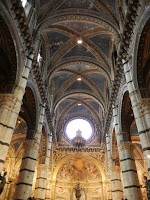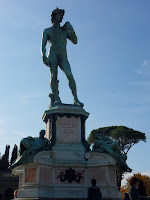
After
San Gimignano, our second stop of the day was Siena. During the Middle Ages it was an independent city-state until it was defeated by Florence.

Afterwards, for a few hundred years, it was so poor that it could not afford to tear down its medieval buildings and replace them with more modern ones. Today, it is a beautifully preserved city right in the heart of Tuscany. Siena was built on three hills, has winding cobbled streets, and is more or less still surrounded by 13th century walls. The historic center was declared a
UNESCO Word Heritage site.

The
Piazza del Campo is one of the greatest medieval squares in Europe. It is shaped like a shell with scalloped edges. This is where the
Palazzo Publico (city hall) and the
Torre del Mangia are. At 102 meters (334 feet), the bell tower is the city's second tallest structure. When it was built in 1848 it was the exact same height of the Duomo to show that the state and church had equal amounts of power. We wanted to visit the tower but unfortunately we got there right after it closed.
Next time.

The white marble
Fonte Gaia (Fountain of Joy) was built in 1419. The original is in a museum somewhere in the city. However, the fountain in the square, which all of the tourists take pictures of, is an exact replica of the original from the mid-19th century.

The
Cathedrale di Santa Maria is Siena's cathedral and is simply called
Duomo. It was completed in the 13th century. In the 14th century, work began to make the Duomo as grand as
St. Peter's Basilica in
Rome.

However, the plague put an end to that effort in 1348.

It is gorgeous!! The façade is white, red and a dark greenish-black marble. The interior has the same greenish-black and white marble. The main attraction inside is the marble inlaid floor with ornate mosaics that cover the entire floor.

Inside is the Piccolomini Library with beautiful frescoes and old choir books.

Il Battistero di San Giovanni is the baptistery. The 14th century building is right behind Il Duomo.
During the Middle Ages, Italian cities were made of districts/wards called
contrade. Siena used to have 59 contrade but consolidation over time has left the city with 17. Each of the 17 contrade has its own name, coat of arms, traditional colors, etc.

Siena is best known for the
Palio – a horse race that is held twice a year on July 2nd and August 16th. Ten horses and riders, dressed in the colors of each respective contrada, race against each other. The race is bareback, three times around the Piazza del Campo and lasts about 90 seconds.
Only 10 of the 17 contrade get to participate in each race. The honor goes to the seven that didn't get to ride in the previous Palio and three more chosen in a drawing. I've heard that the pageantry and rivalries between the contrade are not to be missed.
Who knows? Maybe one day I'll be back in Siena again on a July 2nd or August 16th.

It was 72 km (~45 miles) from Siena to Florence.
The drive through Tuscany this afternoon was so beautiful!!























































